2012 President’s Report
Beyond the Bubble: Sustaining Success for Trinity
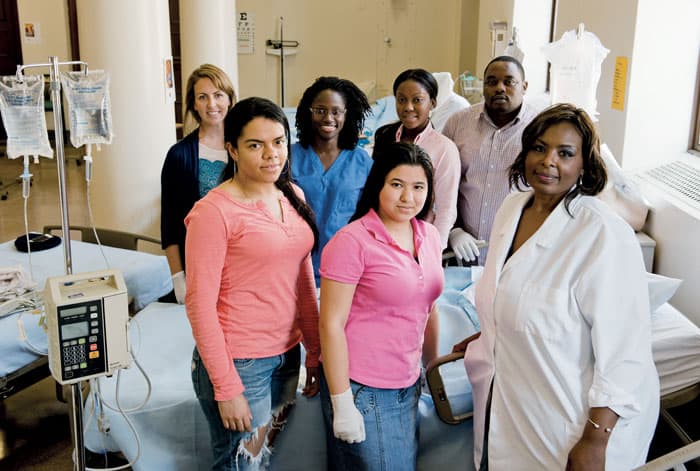
Colleges and universities today live in a precarious bubble – so say some serious analysts solemnly predicting a dire future for the higher learning industry. High tuition prices supported by easy credit in the student loan markets lead to some comparisons with the sub-prime mortgage bubble that collapsed in the recession. In the quest to reduce prices while increasing access, some commentators go so far as to predict major disruption in the very content and organization of higher learning, with new providers delivering the content in remarkable new ways, such as through the phenomena called MOOCs, or “massive open online courses.”
With so much stress and uncertainty in the environment for colleges and universities today, can any historic campus-based institution claim genuine success?
Success. How does Trinity measure success in today’s challenging climate for higher education?
Across Trinity’s 115 years, the quest for success has been deeply ingrained in the college’s culture, starting with Sr. Mary Euphrasia Taylor’s famous phrase – written in 1897 to Sr. Julia McGroarty, who had a rare moment of doubt about the possibility of getting Trinity off the ground – “The project is so grand … the incentives so great. We shall succeed!”
In his January 24, 2012, column reflecting on the ways in which the global economy demands more and even better educated workers, New York Times columnist Thomas Friedman famously wrote, “Average is over.” At Trinity, average has never been good enough. Success at Trinity has always meant so much more than simply meeting objective performance benchmarks or passing the courses required to earn a degree. For Trinity, and for Trinity’s faculty and staff, students and graduates, success means moving beyond merely acceptable work toward truly transformative achievements. How does the work of Trinity make an impact on our world? How do Trinity’s graduates live the values of honor, justice and faith each day? For Trinity, real success is manifest in the ways that Trinity faculty, staff, students and alumnae and alumni serve others each day.
Such high aspirations are important, but can Trinity escape the bubble that threatens the future of many institutions?
Avoiding the consequences of the bubble requires firm grounding in pragmatic solutions to the many challenges of education in the 21st century. A healthy dose of pragmatism supports Trinity’s ambitious mission. Trinity works hard to keep tuition and fees at an affordable level and invests only in those projects that have a clear opportunity for strong returns. Trinity’s faculty and students embrace technology with great enthusiasm, since effective use of technological tools can improve efficiency and effectiveness in teaching and learning. At the same time, Trinity insists on the value of personal attention and care for each student as essential for effective pedagogy and real learning.
Trinity’s mission, curricula, pedagogy and business practices already set this university quite apart from many other institutions of higher education today. Trinity’s distinctive mission – specializing still in the education of women, insisting on the foundation in liberal learning for all professional studies, grounded in Catholic teachings in social justice to be of service to the world – distinguishes Trinity from many larger mass-market institutions that have different ideas about what constitutes success.
In many ways, Trinity lives beyond the bubble – because Trinity’s endowment has always been small, Trinity has a long tradition of keeping expenses within the reality of revenues. This fiscal discipline made it possible for Trinity to thrive after the 2008 recession when many other universities struggled to make up for lost endowment income. Indeed, as this report reveals, Trinity’s strongest financial performance ever has come in the post-recession years as the university grew enrollments while keeping spending modest.

In 2012-2013, Trinity’s greatest challenge lies in finding ways to sustain the university’s trajectory of success. This President’s Report identifies the four key components of Trinity’s current and future success: Enrollment, Financial Performance, Innovative Programming and Creation of the Trinity Academic Center. Sustaining success in these four critical areas will ensure that Trinity stays well beyond the bubble and moving ahead as a distinctive educational option for generations to come.

President Patricia McGuire
Strategic Success: Building Diversified Enrollment
Nearly 25 years ago, in the late 1980s, Trinity began a sustained effort to grow more diversified enrollments. The creation of the Weekend College in 1985 was not Trinity’s first venture into diversified enrollments – indeed, from the very first day Trinity opened in 1900, graduate students were present on campus. In the 1960s, Trinity formalized its commitment to graduate education with the first education degree, the master of arts in teaching.
In the 1970s, Trinity began a degree completion program for older women returning to school, then called Continuing Education. But while the Weekend College drew upon those older strands of innovation, the program also represented a bold new way of thinking for Trinity: the idea of part-time adult education delivered in a different way from the historic full-time undergraduate weekday college was audacious in its scope, in the volume of women who responded, and in the way in which the program drove change in the demographic future of Trinity. A reviewer from the Middle States Commission on Higher Education wrote, in 1991, that Trinity’s decision to venture into adult education was more challenging and transformative than if the college had simply gone co-ed.
Chart 1 shows how Trinity’s enrollments grew and diversified from 1900 to the present day. The yellow area on the bottom is Trinity College, the historic women’s college now also known as the College of Arts and Sciences. The blue area is the School of Education, originating as an M.A.T. program in the mid-1960s. The red area is the School of Professional Studies, starting with the Weekend College in the mid-1980s. The green area on top is Trinity’s newest academic unit, the School of Nursing and Health Professions.

In the early 1990s, Trinity developed its first modern strategic plan (“Toward Trinity 2000”) with a distinctive emphasis on diversifying student populations through diversifying degree programs – “multiple revenue streams” in financial parlance. While Trinity had diverse programs for many prior years, the 1991 strategic plan was the first formal institutional acknowledgment of the fact that Trinity was no longer just an undergraduate women’s college. To manage the diversification of programs in 1991 Trinity also reorganized into two distinct academic units: the College of Arts and Sciences housing the women’s college, and a new School of Professional Studies including the graduate programs in education as well as the Weekend College.
After a successful Middle States review in 1996 affirmed the wisdom of Trinity’s strategic direction, a new strategic plan (“Beyond Trinity 2000”) emerged that was the first plan to establish clear numerical goals to measure success. Based on market research about enrollment and finances necessary to achieve critical mass for institutional success, the new strategic plan established a target of 3,000 total headcount as the essential enrollment goal for Trinity’s next decade. That strategic plan also established parallel goals for financial achievement, growth in programs, technology, human resource development and facilities to support the enrollment growth.
Chart 2 shows the growth in Trinity’s enrollment since 2001. Total enrollment has grown 100% from 1,300 to more than 2,600 total headcount. The College of Arts and Sciences, Trinity’s historic women’s college, has grown by 145% – a faster rate of growth than any other women’s college in the nation.

As Trinity’s growth accelerated after the Year 2000, in keeping with the initiatives of the strategic plan the college reorganized into three major academic units – the College of Arts and Sciences (CAS) remained as the historic weekday women’s college, the School of Education (EDU) became a separate unit, and the School of Professional Studies (SPS) expanded beyond its historic Weekend College model to become a robust evening and weekend program for adults offering both undergraduate and graduate degrees. Significantly, this change also included full coeducation for SPS. In 2010, Trinity added a fourth academic unit, the School of Nursing and Health Professions (NHP).
With so much growth and diversification into the four major academic units, Trinity also reorganized into a university structure, meaning that each academic unit has its own dean and faculty. Academic decisions occur in the academic units with faculty collaboration across units on major committees and through academic assemblies or interdisciplinary programs.
The university structure made it possible for Trinity to achieve important strategic goals: to grow enrollment in each unit with programs tailored to the target populations of students; to foster innovation in programs and pedagogies to serve diverse student populations with many different educational needs and interests; and to build a financial plan that could help Trinity make good choices about investments and more precise means of measuring returns.
The solid performance in enrollment, fostered by the reorganization into the university structure, made it possible for Trinity to reach financial equilibrium after years of instability.
Trinity Vital Statistics 2012 |
|
| Enrollment Total: | 2,663 |
| Full-Time Tuition: | $20,550 |
| Tuition, Room and Board, and Fees: | $30,877 |
| Students Receiving Pell Grants: | 70% |
| D.C. Residents: | 45% |
| Resident Students: | 250 |
| Full-time Faculty and Instructional Staff: | 83 |
| Administrative/Support Staff: | 112 |
| Average Faculty Salary: | $66,200 |
| Operating Budget FY13: | $35,667,000 |
Financial Success: Building a Permanent Foundation for Trinity’s Future
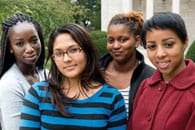
Isatu Dukuray ’14, Beronica Cruz ’15, India Williams ’16 and Sasha Stubblefield ’16
Trinity’s intensive focus on meeting enrollment goals has been essential to establishing the university’s financial foundation for the future. Typical of many small Catholic institutions whose founding religious congregation supported the school for decades through “contributed services” (meaning that the Sisters of Notre Dame worked without taking salaries, an immense “living endowment”), Trinity does not have a large real endowment. Building capital was not a major focus for most Catholic colleges in prior years and Catholic institutions are scarce on any list of wealthy universities. Because meaningful endowments today run to the hundreds of millions of dollars, building endowment over the short term was an unrealistic goal.
For Trinity, building enrollment became the essential driver of restoring financial equilibrium.
Chart 3 shows Trinity’s overall financial growth since 1995. Note that while net assets are growing, liabilities are relatively flat. Trinity is a highly disciplined operation, focusing on controlling expenses while growing assets. This discipline will serve the university well as Trinity prepares to take on new debt for the Trinity Academic Center.
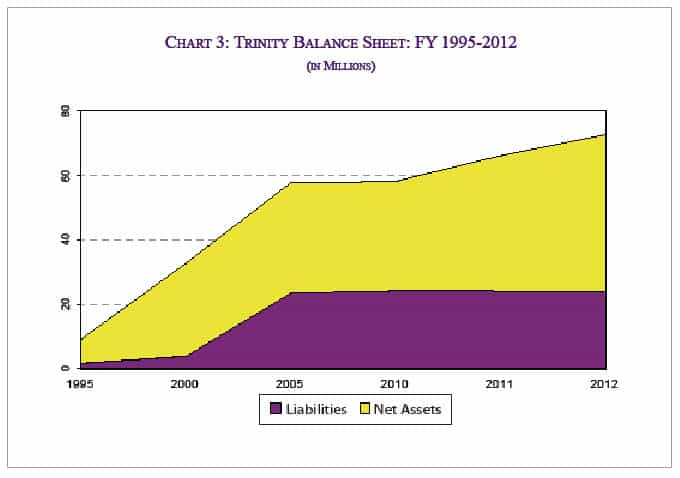
With enrollment growth and disciplined financial management, Trinity has been able to improve its financial performance steadily. The university today has reached a level of financial equilibrium that positions it well for the new building program and continuing future investments in talent and infrastructure.
Chart 4 shows how Trinity performs on a select group of financial indicators. Trinity uses benchmarks derived from Moody’s medians for Baa-rated institutions, as well as medians derived from cohort institutions provided by Trinity’s auditors BrownEdwards.
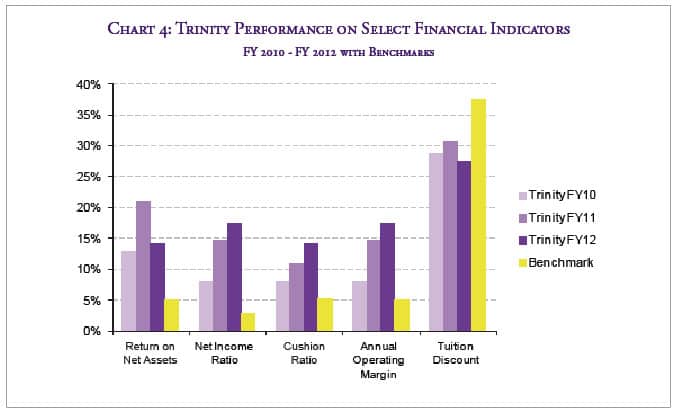 Interpreting the chart and the ratios: Despite a difficult investment climate externally, Trinity’s return on net assets (which combines operating and investment performance) continues to exceed the benchmark considerably. Trinity’s net income ratio, which measures operating performance, is exceptional. The “cushion ratio” is an indicator of the institution’s ability to make debt payments, and Trinity’s performance here is quite strong. The annual operating margin shows the tremendous discipline in Trinity’s expense management. The tuition discount rate is well below the benchmark, which is a very good sign – many private colleges are discounting tuition at dangerously high levels. Despite the relatively high need of Trinity’s students, Trinity is able to support their needs while also keeping the discount rate firmly in hand. These are all indicators of Trinity’s very strong financial management supported by astute oversight of the Board of Trustees.
Interpreting the chart and the ratios: Despite a difficult investment climate externally, Trinity’s return on net assets (which combines operating and investment performance) continues to exceed the benchmark considerably. Trinity’s net income ratio, which measures operating performance, is exceptional. The “cushion ratio” is an indicator of the institution’s ability to make debt payments, and Trinity’s performance here is quite strong. The annual operating margin shows the tremendous discipline in Trinity’s expense management. The tuition discount rate is well below the benchmark, which is a very good sign – many private colleges are discounting tuition at dangerously high levels. Despite the relatively high need of Trinity’s students, Trinity is able to support their needs while also keeping the discount rate firmly in hand. These are all indicators of Trinity’s very strong financial management supported by astute oversight of the Board of Trustees.

Trinity’s annual operating budget is not large for an institution of Trinity’s enrollment size and organizational scope. At just $35.6 million in 2012-2013, Trinity’s budget reflects the university’s historic prudence in spending and careful conservation of resources for the most important investments.
On the previous page, Chart 5 shows the sources of Trinity’s revenues anticipated in the Fiscal 2013 budget. Tuition, as always, is the largest revenue contribution to the budget, with tuition from all four academic units contributing 81% of all revenues.
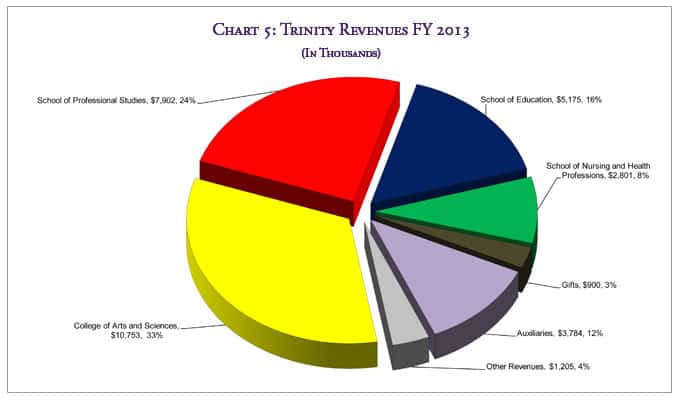
Chart 6 shows Trinity’s anticipated expense allocations in Fiscal 2013. As usual, salaries and benefits are 61% of the budget. Physical plant and utilities account for another 13% of the budget, and security consumes a significant 4% of the budget. This is a budget with almost no “fat” – a real Trinity tradition!
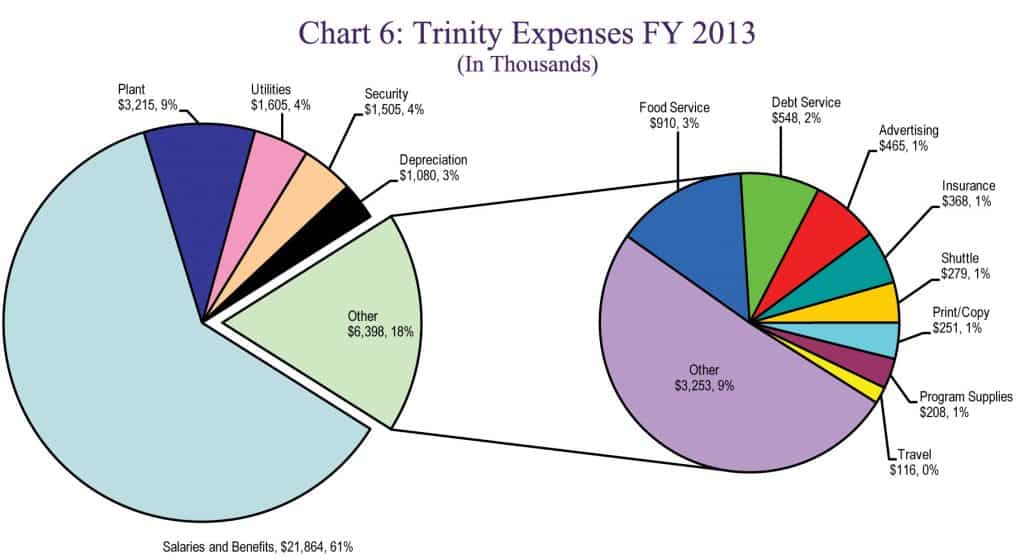
Strategic Program Innovation: Investments in Teaching and Learning
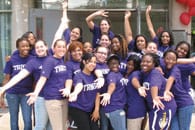
Orientation leaders
Trinity achieved these financial and enrollment successes as a result of many factors: hard work and teamwork by many faculty and staff; increased visibility for Trinity; visionary benefactors willing to invest in the right projects; and trustees with wise insights into the steps necessary to ensure institutional growth. Talented people developing and implementing new programs, as well as fresh approaches to classic curricula, created opportunities for Trinity that proved immensely successful.
Among the many initiatives and innovations that continue to drive Trinity’s success, these continue as top priorities in 2012-2013:
- Health Professions: Success in the nursing program has fostered a climate of continuing innovation in healthcare education at Trinity. In Fall 2012, Trinity launched the occupational therapy assistant program, and anticipates adding the master’s degree in occupational therapy in 2014. Additionally, Trinity now offers undergraduate programs in exercise science and health science with tracks preparing students to continue on in physical therapy. Trinity’s nursing program also anticipates adding the master’s degree in another year.
- Counseling, Psychology and Human Relations: This cluster of undergraduate and graduate programs represent some of Trinity’s largest enrollments. Faculty in all units are engaged in planning work to build upon Trinity’s longstanding success in these disciplines.
- General Education and First Year Success: Trinity is increasingly recognized as one of the universities nationally that has built new pathways to success for first-year students, especially students whose socio-economic circumstances have made good preparation more difficult. Trinity has contributed to the U.S. Department of Education’s website on “promising practices” for first year success, and Trinity is present in numerous discussions with educational experts and policymakers about the importance of strong first year general education to ensure student success.
- Partnerships: Trinity has an extensive web of partnerships throughout the Washington region, including the Girl Scouts, the D.C. Public Schools, Prince George’s Public Schools, Catholic and private schools, and community-serving organizations like the Latin American Youth Center. In Fall 2012, Trinity entered a partnership with KIPP-DC to work with this nationally-recognized charter school organization to promote college access and completion for KIPP graduates. Trinity has also entered a partnership with JumpStart to provide educational services and support for pre-K educational initiatives.
This brief list is only the tip of the iceberg for all of the innovative programs and initiatives that the faculty and staff have undertaken to keep building Trinity’s enrollments. The climate for innovation on campus is strong. However, to keep the momentum for innovation and growth, Trinity must have the infrastructure necessary to support these initiatives. Space and technology are among the greatest challenges in Trinity’s quest to sustain success.
Building to Sustain Success: The Trinity Academic Center
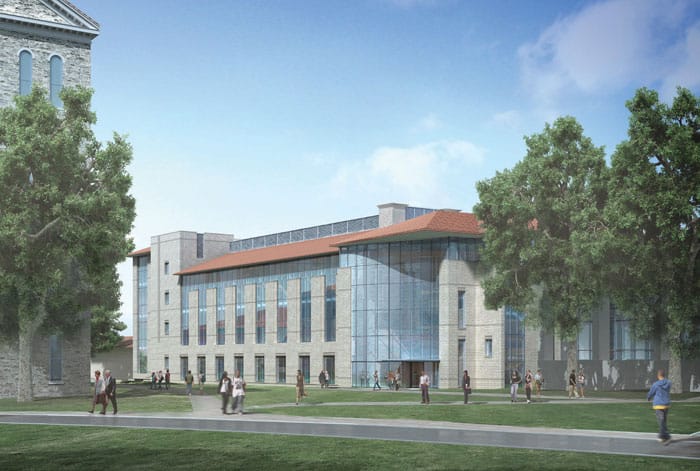
A view of the concept design of the Trinity Academic Center from the front lawn of Main Hall. EYP Architects.
The 2011 President’s Report included an extensive presentation on the plans for the Trinity Academic Center. The Campaign for Trinity’s Second Century to support the center is underway, and many generous benefactors have already made substantial commitments or are considering proposals.
To address the growth in enrollment and diversity of academic programs described in this report, Trinity created the concept design for the Trinity Academic Center, a 118,000-square-foot facility that will house new classrooms, laboratories and related academic spaces including a professional auditorium for lectures and performances. The Trinity Academic Center will achieve these goals for Trinity:
- Support and enlarge Trinity’s academic credibility and competitiveness in higher education by providing contemporary instructional, research and performance spaces for a broad range of academic disciplines.
- Improve Trinity’s ability to recruit and retain highly talented students and faculty who need and deserve a contemporary, functional and safe learning environment to reach their full academic potential.
- Enlarge Trinity’s physical capacity to support a student body in the range of 3,000-3,500 students, Trinity’s strategic target for long-term financial strength.
The plan for the Trinity Academic Center integrates science laboratories, health professions labs, classrooms, faculty offices and study spaces in an efficient design that helps to control construction costs while also fostering multi-disciplinary academic engagement. The Trinity Academic Center is a $55 million project, which, at $467 per square foot, is a relatively modest cost for academic buildings of this size and scope with integrated science laboratories and classrooms.
The Board of Trustees has directed a minimum capital campaign of at least $30 million in order to ensure the financial feasibility of this project. At least $15 million from gifts must be in hand in order to proceed with the design phase of the project. Trinity’s goal is to have the first $15 million in gifts by Spring 2013, with groundbreaking in Spring 2014. This is an ambitious timetable, but essential to move the project forward in a way that supports Trinity’s enrollment growth and programmatic initiatives.
Trinity’s success in the last major building project illustrates what a great building can do for the university. The Trinity Center for Women and Girls in Sports was dedicated in 2002, and in the decade since, Trinity’s enrollment has doubled and its financial profile has reached an exceptionally strong level. The Trinity Sports Center demonstrates the importance of a building program to support strategic goals. The Trinity Academic Center will do far more than that. Because its focus is academic, the new building will truly capture and reflect the scope and vital importance of Trinity’s mission and vision for generations to come.
This President’s Report comes with Trinity’s immense gratitude to all of the great benefactors listed on these pages, and all those who have come before. May the blessings of the Trinity go with you!